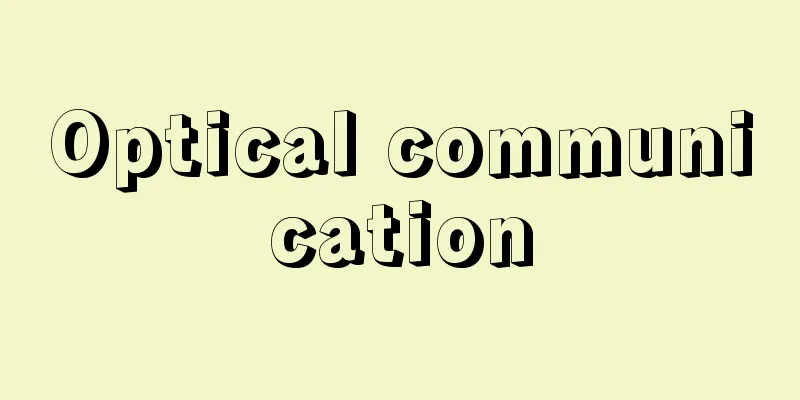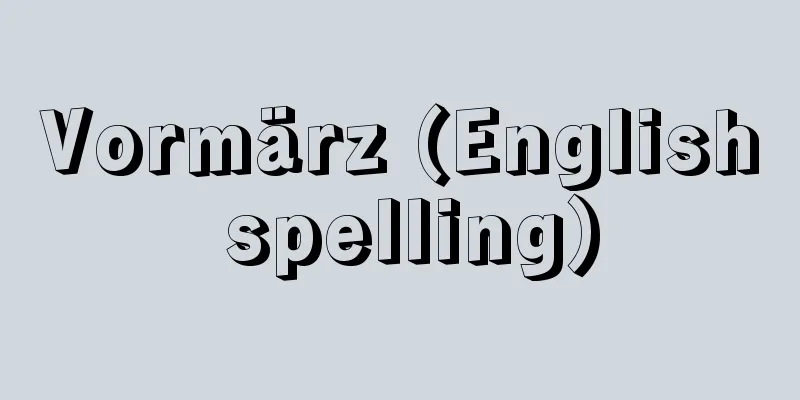Optical communication

|
A communication method that uses light to transmit signals. Optical communication in a broad sense also includes signals that use natural light, such as beacons and semaphore signals, but today, communication that uses laser light or optical fiber is generally referred to as optical communication. [Ryo Tsuboi] History of Optical CommunicationsSince ancient times, humans have transmitted information over long distances by sending off signal fires, flashing lights, and using semaphore signals. These methods can be considered a type of optical communication that uses natural light. A notable experiment in optical communication using natural light was carried out by A. G. Bell, who is famous for inventing the telephone. In 1880, Bell invented the photo-phone, a solar-powered optical telephone, and successfully transmitted a voice signal 213 meters away by varying the intensity of the reflected sunlight according to the waveform of the voice, and then converted the received light back into voice. Since the advent of lasers, methods of communication using light propagating through space have been researched and are in some use, but their use is very limited because light is easily scattered and affected by rain, fog, and obstacles. Research into transmitting light using a dedicated medium rather than propagating through space progressed, and in 1966, C. K. Kao of the British research institute STL (Standard Telecommunication Laboratories) published a historic paper on the possibility of low-loss optical fibers, which marked the beginning of research into communication using optical fibers. This paper analyzed the causes of optical fiber transmission loss, and stated that if impurities in the glass could be removed, it would be possible to reduce the loss to about 20 decibels per kilometer (the light intensity is halved after 150 meters of transmission). Then, in 1970, Corning Inc. in the United States succeeded in creating a prototype optical fiber with a transmission loss of 20 decibels per kilometer, which was astonishingly low for the time. Around the same time, research into semiconductor lasers was also progressing rapidly, and in the same year, Izuo Hayashi (1922-2005) at Bell Labs in the United States succeeded in oscillating a semiconductor laser at room temperature. These results gave the prospect of practical application of optical communications, and research and development into this field began in earnest. After that, progress in reducing loss in optical fiber progressed rapidly, and in 1979, NTT Laboratories and Fujikura Electric Wire succeeded in prototype development of an ultra-low-loss optical fiber with 0.2 decibels per kilometer. Furthermore, research into related technologies such as optical fiber cabling, optical connectors, optical transmitters and receivers, and various optical measuring instruments progressed, and in 1978, an optical fiber cable was laid over a length of about 20 kilometers in central Tokyo, and the first practical optical communication system in Japan was experimented with. This experiment was for optical communications at 32 megabits per second and 100 megabits per second, but at the same time, optical communications at 34 megabits per second and 140 megabits per second were being experimented in the UK, and at 45 megabits per second in the US. The first commercial introduction of optical communication systems in Japan was in 1981 with the F-32M and F-100M systems, which transmitted signals at 32 megabits per second (480 telephone channels per system) and 100 megabits per second (1,440 telephone channels per system) at repeater intervals of 10 to 15 kilometers. Based on the accumulated technology from these introductions, the F-400M system, which transmitted signals at 400 megabits per second (5,760 channels per system) at repeater intervals of 40 kilometers, was put into practical use two years later in 1983, and using this system, the Japan Longitudinal Optical Fiber Cable Transmission Line was completed in February 1985, stretching 3,400 kilometers from Asahikawa to Kagoshima. Furthermore, after the F-2.5G system, which could transmit signals at 2.5 gigabits per second, the F-10G system, which could transmit signals at 10 gigabits per second, was commercially introduced in 1995. Around 2010, an ultra-high-capacity optical communications system was introduced in which 80 optical signals were multiplexed onto a single optical fiber, each transmitting at 40 gigabits per second, for a total transmission capacity of 3.2 terabits per second. [Ryo Tsuboi and Tetsuya Miki] FeaturesCompared with conventional electrical communications, optical communications has the following advantages: (1) Low loss: It has extremely low loss compared to conventional copper wire cables, and the relay distance of the transmission path can be extended to tens of kilometers, which makes it possible to significantly reduce the number of relays or even to connect telephone exchanges without relays. (2) Wideband: It is capable of transmitting much higher frequencies than conventional coaxial cable systems, making it possible to increase capacity. (3) Thin and Lightweight Optical fiber cables are thin and lightweight compared to other transmission media, allowing them to accommodate a large number of cores and making them easier to install. (4) No induction Optical fiber is not affected by electromagnetic induction from external sources (such as high-voltage lines or television and radio waves), making high-quality signal transmission possible. [Ryo Tsuboi and Tetsuya Miki] The spread of optical communicationsOptical communications have been introduced not only for long-distance terrestrial transmission lines, but also as undersea cables, realizing the digitalization and large-capacity of international communications, and supporting the international broadband Internet. Submarine optical cables were first commercially introduced in Japan between Hachinohe and Tomakomai, and between Miyazaki and Okinawa in 1986. Internationally, the TAT-8 system undersea optical cable was opened between the United States and the United Kingdom and France in December 1988, and since then, the use of undersea optical cables has spread remarkably, becoming the mainstream of international communications. In the Pacific, the TPC-3 system was opened between Japan and the United States in April 1989, and further undersea optical cables between Asian countries have been laid. As a result of optical communications being introduced into domestic and international trunk networks, it has become possible to significantly reduce communication charges for both domestic and international communications. Meanwhile, as the broadband Internet becomes more common, the number of subscribers to FTTH (fiber to the home), a subscriber line using optical fiber, is rapidly increasing, along with CATV (cable television) and ADSL (asymmetric digital subscriber line). In addition, as mobile communications become more broadband, the number of wireless base stations is rapidly increasing, and optical communications for connecting to communication centers, base stations for automobiles on highways, and for train communications are becoming more widespread. [Tetsuya Miki] [Reference] | |©Shogakukan "> Bell's principle of optical telephone Source: Shogakukan Encyclopedia Nipponica About Encyclopedia Nipponica Information | Legend |
|
光を用いて信号を伝える通信方式。のろしや手旗信号のように、自然光を利用した信号も広い意味の光通信であるが、今日では一般にレーザー光や光ファイバーを用いた通信を光通信とよんでいる。 [坪井 了] 光通信の歩み古来、人間は、のろしをあげたり、灯火を点滅させたり、手旗信号を用いたりする方法によって情報を遠くへ伝えていた。これらは、自然光を利用した一種の光通信であるといえる。 自然光を利用した光通信の特筆すべき実験を行ったのは、電話の発明で有名なA・G・ベルである。ベルは1880年に太陽光を使った光線電話photo-phoneを考案し、声の波形に応じて太陽の反射光の強度を変化させて213メートル先まで伝送し、受けた光線を音声に戻す実験に成功している。このような光の空間伝搬による通信は、レーザーが出現して以来、それを光源とする方式が研究され一部で使われているが、光が散乱したり、雨や霧あるいは障害物などの影響を受けやすいため、その利用は非常に限定される。 光を空間伝搬せずに、専用の媒体を用いて伝送する研究がその後進められ、1966年イギリスの研究所STL(Standard Telecommunication Laboratories)のC・K・カオによって低損失な光ファイバーの可能性に関する歴史的な論文が発表されたのを契機に、光ファイバーを用いた通信の研究が開始された。この論文は光ファイバーの伝送損失の要因について分析し、ガラスの中の不純物を取り除くことができれば、1キロメートル当り20デシベル(150メートル伝搬した所で光の強度が半分になる)程度の低損失化も可能であることを述べたものである。そして1970年にはアメリカのコーニング社において、1キロメートル当りの伝送損失が20デシベルという、当時としては驚異的に低損失な光ファイバーの試作が成功した。ちょうどその時期に、半導体レーザーの研究も急速に進んでおり、同じ1970年にアメリカのベル研究所において林厳雄(いづお)(1922―2005)が室温での半導体レーザーの発振に成功した。これらにより、光通信の実用化の見通しが得られ、その研究開発が本格化した。 その後、光ファイバーの低損失化は急速に進展し、1979年(昭和54)には1キロメートル当り0.2デシベルという超低損失の光ファイバーがNTT研究所と藤倉電線により試作に成功した。さらに、光ファイバーのケーブル化、光コネクター、光送受信器、各種の光測定器など関連する技術の研究が進展し、1978年には東京都心の約20キロメートルに光ファイバーケーブルが敷設され、日本での最初の実用的な光通信システムの実験が行われた。この実験は、毎秒32メガビットおよび毎秒100メガビットの光通信であったが、同時期にイギリスでは毎秒34メガビットおよび毎秒140メガビット、アメリカでは毎秒45メガビットの光通信が実験された。 日本最初の光通信システムの商用導入は、1981年に毎秒32メガビット(システム当り電話480チャネル伝送)および毎秒100メガビット(システム当り電話1440チャネル伝送)の信号を中継間隔10ないし15キロメートルで伝送するF-32MシステムおよびF-100Mシステムが始まりである。これらの導入による技術の蓄積をベースに、2年後の1983年には毎秒400メガビット(システム当り5760チャネル伝送)の信号を中継間隔40キロメートルで伝送するF-400Mシステムが実用化され、この方式を用いて1985年2月には、旭川(あさひかわ)から鹿児島まで3400キロメートルに及ぶ日本縦貫光ファイバーケーブル伝送路が完成した。さらに、毎秒2.5ギガビットのF-2.5Gシステムを経て1995年(平成7)には毎秒10ギガビットのF-10Gシステムが商用導入された。2010年ごろには1本の光ファイバーに80波の光信号を多重化し、おのおのが毎秒40ギガビットの伝送を行い、全体で毎秒3.2テラビットの伝送能力をもつ超大容量の光通信システムも導入されている。 [坪井 了・三木哲也] 特長光通信は従来の電気通信に比べ、次のような特長がある。 (1)低損失 従来の銅線ケーブルに比べきわめて低損失であり、伝送路の中継距離を数十キロメートルと非常に長くすることができるため、中継器数の大幅削減、あるいは電話局間を無中継で結ぶことも可能となる。 (2)広帯域 従来の同軸ケーブル方式に比べはるかに高い周波数を伝送できるので、大容量化が可能となる。 (3)細径・軽量 光ファイバーケーブルは他の伝送媒体に比べ細径・軽量であるため、多数の心線を収容できるとともに敷設にも有利である。 (4)無誘導 光ファイバーは、外部(高電圧線やテレビ、ラジオの電波など)からの電磁誘導を受けないため、高品質な信号伝送が可能となる。 [坪井 了・三木哲也] 光通信の普及光通信は陸上の長距離伝送路だけではなく、海底ケーブルとしても導入され、国際通信のデジタル化と大容量化を実現し、国際的なブロードバンドインターネットを支えている。海底光ケーブルは、国内では1986年に八戸(はちのへ)―苫小牧(とまこまい)間、宮崎―沖縄間に商用導入された。国際的には、1988年12月アメリカとイギリス・フランス間にTAT-8システム海底光ケーブルが開通、以後海底光ケーブルの普及が目覚ましく、国際通信の主流となっている。太平洋においても1989年4月にTPC-3システムが日米間で開通し、さらにアジア諸国との間に海底光ケーブルの敷設が進められてきた。 こうして光通信が国内および国際の幹線ネットワークに導入されてきた結果、国内通信、国際通信ともに、その通信料金の大幅な低廉化を可能にした。 一方、インターネットのブロードバンド化が進行するにつれて、その利用手段として、CATV(ケーブルテレビ)、ADSL(非対称デジタル加入者回線)と並んで、光ファイバーを用いた加入者線であるFTTH(fiber to the home)が急速に加入者数を伸ばしている。また、移動通信のブロードバンド化が進むにつれ、無線基地局の数が急速に増加し、通信センターと接続するための光通信や、高速道路などでの自動車向け基地局や、列車通信用の光通信の普及も進んでいる。 [三木哲也] [参照項目] | |©Shogakukan"> ベルの光線電話の原理 出典 小学館 日本大百科全書(ニッポニカ)日本大百科全書(ニッポニカ)について 情報 | 凡例 |
<<: Optical lever - Hikari-teko (English spelling) optical lever
Recommend
Stavisky, SA (English spelling)
…A French corruption scandal caused by a Russian-...
Terminalia catappa L.
A semi-deciduous tall tree of the Combretaceae fam...
Kyros
… The weakening of centralism, which had been bre...
Lamut
… [Classification and distribution] The Tungusic ...
Quicksand - Quicksand (English spelling)
When fine sand is subjected to an upward seepage ...
récit (English spelling)
… What is a story? Narratives are generally consi...
Badger State
…There is also a legend that a badger's legs ...
Hitachiyama Taniemon
Year of death: June 19, 1922 Year of birth: Januar...
Magnetic relaxation
A phenomenon in which a time delay occurs before t...
cathedral (English spelling) cathedral
…It is also called a church. A church with a bish...
Arima Yorishige
1828-1881 A feudal lord from the end of the Edo p...
Liquid surface combustion
… In the case of liquids and solids, the spread o...
Izanami-no-Mikoto
In Japanese mythology, Izanagi Izanagi no Mikoto S...
Hiuchi (English spelling) horizontal brace
This refers to a diagonal member or board used to ...
Imi-bi - Imi-bi
Also written as "saibi," it has two oppo...




![Fuji [town] - Fuji](/upload/images/67ccb205d4135.webp)




